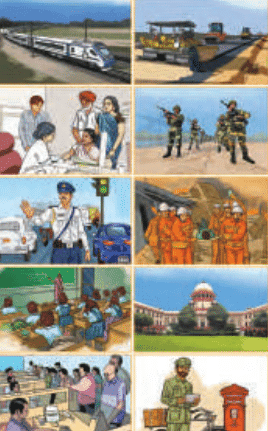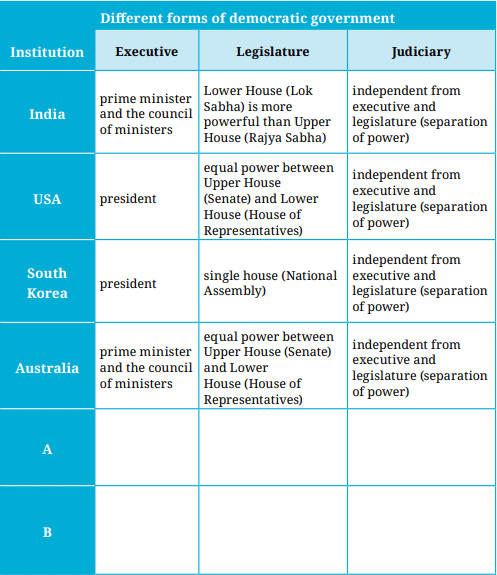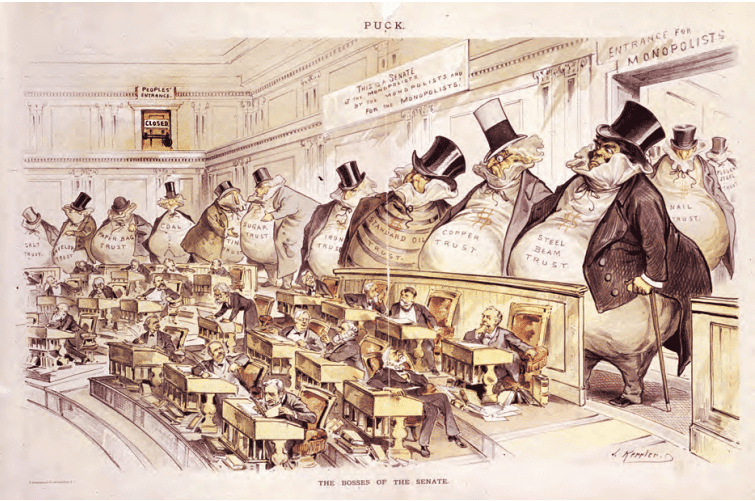Class 7 Social Science Chapter 9 Let's Explore - From the Rulers to the Ruled: Types of Governments
| Table of contents |

|
| Page 186 & 188: What is Government? |

|
| Page 196: What do these terms mean? |

|
| Page 199: Think About It |

|
| Page 204 to 206: Story of Shane |

|
Page 186 & 188: What is Government?
Q: Do you remember this picture from your Grade 6 textbook? The government also has many other roles. Try to list them.
Ans: Picture Recognition: The picture (Fig. 9.2) likely depicts a government-related scene from the Grade 6 textbook, such as a parliament or civic activity. Students should confirm if they recall it, e.g., "Yes, it looks like the Indian Parliament from Grade 6." Fig. 9.2
Fig. 9.2
Other Roles of Government: Beyond the listed roles (maintaining law and order, ensuring security, managing foreign relations, national defense, delivering services, managing the economy, and citizen welfare), additional roles include:
- Promoting cultural heritage (e.g., preserving monuments).
- Environmental protection (e.g., pollution control).
- Disaster management (e.g., relief during floods).
- Regulating trade and commerce (e.g., setting tariffs).
- Ensuring social justice (e.g., affirmative action for marginalized groups).
Q: Which of the three methods do you think is most effective? Why?
Ans: Methods:
- Everyone in the school joins the committee.
- The Head Teacher selects committee members.
- Students elect representatives through voting.
Most Effective: The third method (electing representatives) is most effective.
Why:
- It ensures fair representation from each grade, reflecting diverse student needs.
- Voting empowers students, fostering participation and accountability.
- Unlike the first method, it avoids chaos from too many decision-makers.
- Unlike the second method, it prevents bias and ensures students’ voices are heard, aligning with democratic principles.
Page 196: What do these terms mean?
Q 1: Fill the blank columns under Country A and Country B in table 9.1 given on the previous page by taking two different countries of your choice. Analyse the table and discuss amongst yourselves the similarities and differences in all the examples.
Ans: Filling Table 9.1 for Country A (Canada) and Country B (France):
Analysis of Similarities and Differences:
Similarities:
- All countries (India, USA, South Korea, Australia, Canada, France) have independent judiciaries, ensuring separation of powers.
- All are democracies with elected legislatures.
- Executive and legislative roles are distinct but interconnected.
Differences:
- Executive Structure: India, Australia, and Canada have parliamentary systems (Prime Minister from legislature), while USA, South Korea, and France have presidential or semi-presidential systems (President elected separately).
- Legislative Power: India’s Lok Sabha is more powerful than Rajya Sabha; USA and Australia have equal house powers; South Korea and France have single or dominant lower houses.
- Formation: Canada’s Senate is appointed, France’s Senate is indirectly elected, unlike India’s mixed Rajya Sabha election.
Q2: After studying the above examples, list the core principles of a democratic government. Based on your understanding, do the activity given below:
You have to form a Student Committee in your school. Make a plan and execute it in a democratic manner, ensuring that:
♦ Functions of the committee are well defined
♦ The election process of the committee members is democratic
Ans: Core Principles of a Democratic Government:
- Equality: Equal treatment and access to opportunities for all citizens.
- Freedom: Right to make choices and express opinions.
- Representative Participation: Electing representatives through elections.
- Universal Adult Franchise: Voting rights for all adults above a certain age.
- Fundamental Rights: Protecting rights like speech, equality, and freedom from exploitation.
- Independent Judiciary: Ensuring laws and rights are upheld impartially.
- Accountability: Government answerable to the people.
Functions of the Committee:
- Legislative: Create rules for school activities (e.g., timetables, No Bag Day events).
- Executive: Implement rules (e.g., organize sports, manage mid-day meals).
- Judicial: Ensure compliance (e.g., monitor rule adherence, resolve disputes).
- Specific tasks: Plan morning assemblies, manage cleanliness drives, coordinate festivals.
Democratic Election Process:
- Nomination: Each class nominates 2–3 candidates who volunteer.
- Campaign: Candidates share their plans (e.g., posters, speeches in assembly).
- Voting: Secret ballot for all students, one vote per student, supervised by teachers.
- Counting: Transparent vote counting with student observers.
- Result: One representative per class forms the committee, ensuring fair representation.
- Tenure: Fixed term (e.g., one semester), with re-elections to maintain accountability.
Page 199: Think About It
Q: What might happen if the king considered himself to have divine powers? How would he rule over the people?
Ans: Consequences of Divine Power Claim: If a king believes he has divine powers, he may assume absolute authority, viewing himself as infallible and above questioning. This could lead to:
- Arbitrary rule, ignoring dharma or people’s welfare.
- Suppression of dissent, as criticism is seen as blasphemy.
- Exploitation, prioritizing personal or elite interests over public good.
- Potential for corruption, as unchecked power fosters ego (per Mahābhārata’s warnings).
- Ruling Style: He might rule autocratically, making laws without consultation, enforcing them harshly, and adjudicating disputes to favor loyalists. Unlike the Rājataranginī example, where the king respected a cobbler’s rights, a “divine” king might disregard commoners, leading to unrest or rebellion.
Page 204 to 206: Story of Shane
Q: Does Shane’s country look like a democracy? How do you think Shane’s everyday life would be? Would you like to live in such a country? Explain why.
Ans: Is Shane’s Country a Democracy? No, Shane’s country (North Korea) does not resemble a democracy. It exhibits dictatorship traits: strict government control over personal choices (haircuts, clothes), mandatory military service, restricted internet access, and surveillance, indicating a lack of freedom, equality, or citizen participation.
Shane’s Everyday Life: Shane’s life is highly regulated. He follows government-mandated rules for appearance and behavior, serves in the military without choice, and lacks access to global information. Constant surveillance creates fear, limiting self-expression, and he must report rule-breakers, reducing trust in society.
Would You Like to Live There? Why? No, living in such a country would be undesirable because it restricts personal freedom, suppresses individuality, and denies rights like free speech or choice. A democracy, with its emphasis on equality and participation, offers a freer, more inclusive life.
Q: Look carefully at the picture in Fig. 9.13 on the previous page. It depicts an elected body in the USA in the late 19th century. The people shown in the cartoon are all elected members. What do you observe? What do you see at the top left-hand corner of the cartoon? Who do you think is making decisions in this elected body? Can a democracy turn into an oligarchy? What can people do to keep democracy strong?
Ans: Observations of Fig. 9.13: The cartoon shows elected members in a legislative body, but they appear influenced by external forces, suggesting limited autonomy. The setting implies wealth or elite control over decisions.
- Top Left-Hand Corner: Likely depicts a symbol of wealth or power (e.g., a wealthy figure, corporate emblem, or money bag), indicating influence by a small, powerful group.
- Who Makes Decisions? A small group of wealthy or influential individuals (e.g., industrialists or aristocrats) likely controls decisions, overshadowing elected members, hinting at an oligarchic influence within a democratic system.
- Can a Democracy Turn into an Oligarchy? Yes, if wealth concentrates power, politicians prioritize elite interests, or institutions like media and judiciary are manipulated by a few.
- Keeping Democracy Strong:
- Vote responsibly to elect accountable representatives.
- Demand transparency in governance (e.g., public financial disclosures).
- Support independent media and judiciary to check power.
- Participate in civic activities (e.g., protests, petitions) to voice concerns.
- Educate citizens about democratic rights to prevent elite capture.
Q: You have learnt the basic characteristics of various forms of governments. Do a small role play of the various forms in your classroom:
Enact democracy
Enact monarchy
Enact dictatorship
What do you find to be the most suitable form of government?
Ans: Role Play Enactments:
- Democracy: Students elect a leader via a mock vote (e.g., class monitor). The leader forms a committee, discusses rules (e.g., classroom cleanliness), and seeks group input. Decisions reflect majority consensus, with freedom to express opinions.
- Monarchy: One student acts as a king/queen, inheriting power (e.g., “crowned” by the teacher). They make rules (e.g., homework deadlines) with advice from a “council” but retain final say. Citizens (students) have limited input.
- Dictatorship: One student is appointed dictator, making unilateral rules (e.g., no talking in class) without consultation. Others must obey or face “punishments” (e.g., extra tasks). No freedom to dissent.
- Most Suitable Form: Democracy is most suitable because it ensures participation, equality, and accountability. Students experience freedom to voice ideas and change leaders via elections, unlike monarchy’s limited input or dictatorship’s oppression, aligning with values of fairness and inclusion.
|
23 videos|204 docs|12 tests
|
FAQs on Class 7 Social Science Chapter 9 Let's Explore - From the Rulers to the Ruled: Types of Governments
| 1. What does the term 'rulers' refer to in historical contexts? |  |
| 2. How did the relationship between rulers and the ruled shape societies in the past? |  |
| 3. What roles did common people play in the governance of their societies? |  |
| 4. How did social class divisions impact the daily lives of people in ancient civilizations? |  |
| 5. What lessons can we learn from the historical dynamics between rulers and the ruled? |  |















